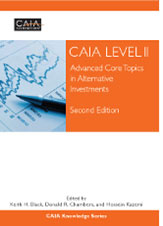Keith Black, Ph.D., CAIA, CFA
The readings for the CAIA program, the basis for a comprehensive education in the growing sector of alternative investments, are evolving. Written under the direction of the CAIA Association, the second edition of the textbook, CAIA Level II: Advanced Core Topics in Alternative Investments, brings insights from practicing professionals and leading experts in the field of alternative investments. In this issue of AIAR, we have included a roundtable interview, where a number of the authors of this textbook discuss recent developments in, and the future of, the various sectors of alternative investments.

The second edition of the textbook has been thoroughly revised to bring the latest contents and developments in the core areas of alternative investments, including private equity and venture capital, real estate and real assets, commodities, and hedge funds and managed futures. As the book was being revised, the authors and editors kept a keen focus on readability. The readings are designed to be easier to understand, as each keyword is defined the first time it is mentioned to assist in students’ mastery of the professional vocabulary and their corresponding concepts.
There have been substantial additions and revisions to the content of the real assets and commodities sections. In recent years, there has been a strong increase in the assets allocated to investments in areas such as farmland, timberland, infrastructure and intellectual property. CAIA has responded to this dynamic corner of the alternative investments industry by adding all-new content to the textbook to ensure that readers keep up-to-date with these rapidly growing asset classes. Within commodity markets, chapters have been added to focus on risk management, as well as the impact of interest rates, currency markets and business cycles on the supply and demand of commodities. Readers also learn about the unsmoothing of appraisal-based returns, which, in the context of real estate, explains how REITs and private real estate may have much more similar risk and return characteristics than when viewed through the lens of reported returns.
The material in the section discussing hedge funds and managed futures has also been revised and updated. A highlight of this content includes discussions on factor models and hedge fund replication. Rather than accepting that a hedge fund or managed futures fund has earned alpha when compared to a single-factor model, such as an equity market index, investors need to define risk more broadly. The use of alternative betas in a factor model, such as momentum, currencies or commodities, can yield a more accurate view of the risks taken, and value added, by each fund manager. Risk management and due diligence are also emphasized in this section, including the risks of how prime brokers, custody arrangements and futures commission merchants have impacted the industry since 2008. Whenever possible, examples from global markets are used, such as the extended discussion of currency markets in the context of global macro investing.
Finally, an all-new section on asset allocation and portfolio management has been added. This section introduces the important role of endowments, foundations and pension funds as large and influential investors in alternative investments. Endowments and foundations have been large allocators to alternative investments, but these large allocations come with the need to manage liquidity risk as well as understand the impact that the portfolio can have on the spending needs of the institution. Within pension plans, a shift from defined benefit to defined contribution and liability-driven investing schemes may have a substantial impact on the alternative investments industry.
All of these improvements ensure that readers of all backgrounds will receive the best and most up-to-date education in alternative investments. Designed to provide real-world relevance to alternative investment professionals, the second edition of the textbook, CAIA Level II: Advanced Core Topics in Alternative Investments, serves as a solid reference for those needing to keep pace with the rapidly changing world of alternative investments.






